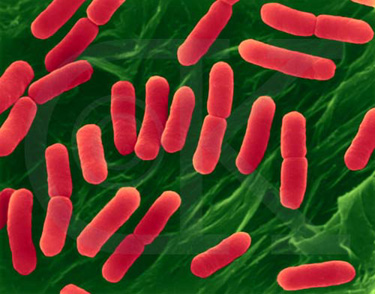Click here to learn more about coevolution, the process where interacting species evolve in response to each other. Understanding coevolution is important in the appreciation of the complexities of ecological interactions.
Photo from - http://www.sci.sdsu.edu/classes/bio508/Mimicry.html
A macroscopic example of coevolution is the dynamic ecological system of the coral reef. Since our focus is microscopic, we will consider the coevolution of microbes with each other as well as with multicellular organisms. The study of microbial ecology is vital to the understanding of coevolution. It allows us a glimpse into the very early events of evolution.
Coevolution associated with parasitism is frequently referred to as "the coevolutionary arms race." Evolutionary rate is directly affected by the probability of the host developing resistance to a microbial parasite, resulting in the parasite increasing its virulence. The host may then evolve resistance to the new virulence factor causing the microbe to evolve ever increasing virulence
Click here to learn more about microbial parasites.

Photo from - http://www.kent.k12.wa.us/staff/kloschky/MoneransFolder/Moneran%20Graphics/Thumbnails/bactimages.htm
.
Click here to learn more about virulence factors.The result of this coevolutionary arms race is that both the host and the parasite expend tremendous amounts of their energy, resources and genomes trying to out-compete each other. Millions of years of these interactions result in a long and winding road of both efficient and obsolete mechanisms for resistance/defense by the host and virulence factors by the parasite. Click here to learn about antibiotic resistance. Antibiotic resistance is one of the the most obvious present methods by which microbes get ahead in the arms race.
The interrelationship between humans, Anopheles mosquitoes, and the protist Plasmodium falciparum (Click here to learn about Plasmodium) is a well-documented example of coevolution. Malaria (Click here to learn about malaria) is a disease that causes fever, chills, anemia and the blocking of blood vessels and may result in coma and death. It is contracted when mosquitoes containing Plasmodium bite humans, injecting the protist into the bloodstream. Plasmodium cannot complete its life cycle (Click here for Plasmodium life cycle) until it has inhabited both Anopheles and humans. Coevolution of humans, Anopheles,

Photo from - http://www.sun-city-south-africa.com/safaris.asp
and Plasmodium may be traced, revealing possible migratory times and routes of early humans. Click here to learn more about the coevolution of Plasmodium, Anopheles and humans.
Coevolution associated with mutualism results in adaptations that are beneficial to both organisms. This may have become necessary due to the sharing of the same niche and/or habitat. In this case, the coevolutionary arms race is directly affected by one organism evolving into a more fit form and resultantly, the microbial organism that shares its niche/habitat must evolve in response.


